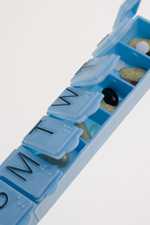Biomedical Research
Biomedical research has given us powerful new tools to prevent HIV transmission. Those at very high risk for getting HIV can take PrEP, a daily pill that greatly reduces their chance of getting HIV. People who have been exposed to HIV can take PEP, medicine that can reduce the chance of becoming HIV-positive, if started within 3 days of exposure. Furthermore, treatment for those who have HIV infection, called ART, is now a proven prevention strategy. CDC has identified the best practices and most effective prevention strategies in the Compendium of Evidence-Based Interventions. Read more about these developments and the CDC’s biomedical prevention research.
CDC HIV Related Research
 PrEP is short for Pre-Exposure Prophylaxis. It is a new HIV prevention method in which people who do not have HIV take a daily pill to reduce their risk of becoming infected. When used consistently, PrEP has been shown to be effective in men who have sex with men and heterosexually active men and women.
PrEP is short for Pre-Exposure Prophylaxis. It is a new HIV prevention method in which people who do not have HIV take a daily pill to reduce their risk of becoming infected. When used consistently, PrEP has been shown to be effective in men who have sex with men and heterosexually active men and women.
 The advent in 1996 of potent combination antiretroviral therapy (ART), sometimes called HAART (highly active antiretroviral therapy) or cART (effective combination antiretroviral therapy), changed the course of the HIV epidemic. These “cocktails” of three or more antiretroviral drugs used in combination gave patients and scientists new hope for fighting the epidemic, and have significantly improved life expectancy—to decades rather than months.
The advent in 1996 of potent combination antiretroviral therapy (ART), sometimes called HAART (highly active antiretroviral therapy) or cART (effective combination antiretroviral therapy), changed the course of the HIV epidemic. These “cocktails” of three or more antiretroviral drugs used in combination gave patients and scientists new hope for fighting the epidemic, and have significantly improved life expectancy—to decades rather than months.
Post-Exposure Prophylaxis
Non-Occupational Post-Exposure Prophylaxis
- Guidelines for Nonoccupational Exposure
- Antiretroviral Postexposure Prophylaxis after Sexual, Injection-Drug-Use, or Other Nonoccupational Exposure to HIV, in the United States: Recommendations from the U.S. Department of Health and Human Services
Occupational Exposure & Post-Exposure Prophylaxis
- Updated U.S. Public Health Service Guidelines for the Management of Occupational Exposures to HIV and Recommendations for Postexposure Prophylaxis
- Updated U.S. Public Health Service Guidelines for the Management of Occupational Exposures to HBV, HCV, and HIV and Recommendations for Postexposure Prophylaxis
- The National Clinicians’ Post-Exposure Prophylaxis Hotline (PEPline)
- Page last reviewed: February 2, 2017
- Page last updated: February 2, 2017
- Content source: Division of HIV/AIDS Prevention, National Center for HIV/AIDS, Viral Hepatitis, STD, and TB Prevention, Centers for Disease Control and Prevention


 ShareCompartir
ShareCompartir